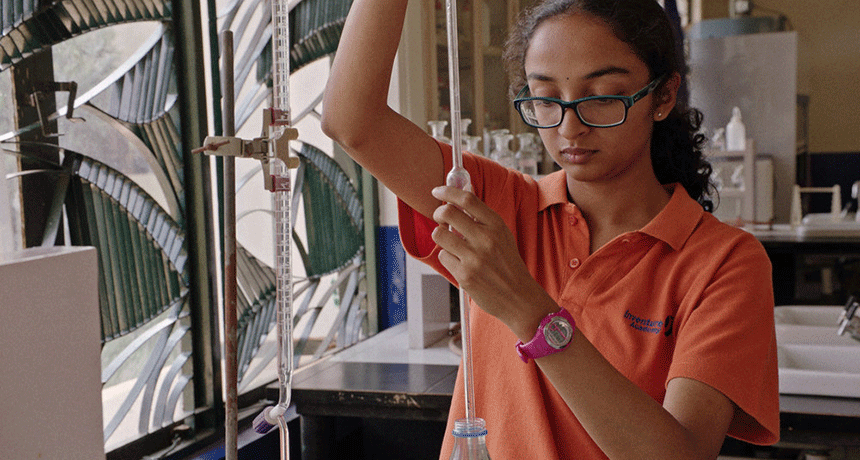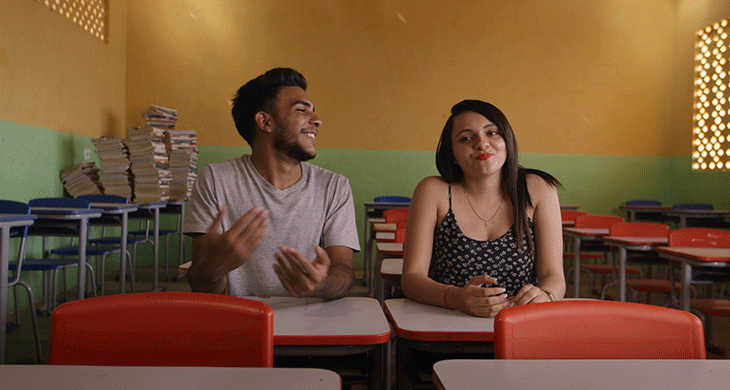New movies give an inside look at the ‘Olympics’ of science fairs
‘Science Fair’ and ‘Inventing Tomorrow’ take viewers behind the scenes of Intel ISEF

Sahithi Pingali, 16, works on her science fair project in Inventing Tomorrow.
IQ190 Productions LLC
In this event, there are talented, brilliant teens. Demanding coaches. Months of training and preparation. Triumph and tragedy. These high school students have been working for years to get to one, final week of competition. More than 1,700 students will compete, and the judges are tough. There are medals and college scholarships to win. And thousands of dollars are on the line.
But this isn’t football. It’s not gymnastics or swimming or track. This is a science fair.
Two new documentaries — Inventing Tomorrow and Science Fair — take audiences behind the trophies and scientific posters of the Intel International Science and Engineering Fair. Created by Society for Science & the Public and sponsored by Intel, ISEF brings together thousands of budding scientists each year. In one whirlwind week, they compete for prizes and present their science fair projects to the public. (The Society also publishes Science News for Students and this blog, and gave Inventing Tomorrow special access to the competition.)
In Inventing Tomorrow, director Laura Nix follows teens as they take on environmental issues close to home and bring their solutions to ISEF. Sahithi Pingali, 16, for instance, hates the trash piling up in her local lakes in Bangalore, India. She designs a water testing app to help her neighbors monitor water quality. Meanwhile, Jose Manuel Elizade Esparaza, 18, Jesus Alfonso Martinez Aranda, 17, and Fernando Miguel Sanchez Villalobos, 17, design a paint to absorb the air pollution plaguing their home in Monterrey, Mexico.
They, along with teams from Indonesia and Hawaii, collect their data, analyze the results and practice the scientific talks they will give to the judges. Some face challenges when team members can’t join them at ISEF. Others struggle with presenting their projects in English.
The tone of Inventing Tomorrow is inspiring. The teens it shows are driven to solve the environmental problems where they live. “It is our job as the next generation to tackle this,” Sahithi notes.
The science fair of science fairs
Science Fair doesn’t have such a unifying scientific message. Instead, it focuses more on the different types of teens who end up at ISEF, and why they want to be there so desperately.
For example, Robbie Barrat, 17, struggles in school in Shenandoah, W. Va. But he excels at home, teaching computers how to rap like Kanye West. Ivo Zell, 18, lives to fly model planes in Loch, Germany. He channels his passion into inventing a new flying wing. Myllena Braz da Silva, 17, from Ceará, Brazil, tackles the Zika virus that has invaded her hometown.
(Review continues after image)

The kids in Science Fair seem a bit more realistic than the ideal dreamers of Inventing Tomorrow. They have their own motivations, and their own squabbles. Some are hard-driving science fair achievers. Others hop on the plane to ISEF after a wild prom night. Robbie needs a stellar performance in a science fair to make up for dismal school grades. Myllena hopes that an ISEF win will help her move beyond poverty-stricken town and give her more opportunities.
Both movies culminate at the 2017 Intel ISEF in Los Angeles, Calif. There, kids battle nerves, get the flu, party, make friends and — in the case of Ivo — take home a prize of $75,000.
While the movies are both about the same big science fair, neither is really about the science the teens carry out. Inventing Tomorrow emphasizes how motivated the teens are to solve environmental issues with science. Science Fair focuses on how the teens present their research. It’s not clear how the students came up with their projects, how they did the science itself or how they found mentors at universities to help them.
Instead, the two movies focus on the experience of competing at a huge science fair. It’s a place where kids bring their wildest scientific ideas. They find more people like themselves. And it’s something that all the teens hope will help them succeed in life.
And there’s no question that ISEF had huge impact on these teens, whether they won $75,000 or not. Jesus from Inventing Tomorrow couldn’t afford college classes. But his success in science fair got him a scholarship. Sahithi got a summer internship at the University of Michigan, to continue her studies on water quality. Science Fair’s Robbie gets a job offer and ends up working with the computers he loves.
Along the way the teens meet scientists, make friends and come up with more ideas for research. The science fair is far more than just a competition, Robbie says. “If you’re there to win the prize and that’s it, you’re missing the point of science fair.”
Inventing Tomorrow premiered at the Sundance Film Festival and opened in select theaters on August 31.
Science Fair is a documentary from National Geographic. It premiered at South by Southwest and at Sundance. It opens in limited theaters September 14.
Follow Eureka! Lab on Twitter